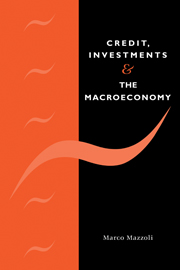Book contents
- Frontmatter
- Contents
- Preface and acknowledgements
- 1 Introduction
- Part I Banks, credit and the macroeconomy: a puzzle
- Part II Interactions between credit and industry: firms' market power and banks' liquidity preference
- 4 Investments and monetary policy with oligopsony in the market for credit
- 5 Banks' assets and liquidity preference: an empirical investigation based on the free liquidity ratio for commercial banks
- Part III ‘Inside-the-firm’ interactions between finance and investments
- Summing up …
- Bibliography
- Index
4 - Investments and monetary policy with oligopsony in the market for credit
from Part II - Interactions between credit and industry: firms' market power and banks' liquidity preference
Published online by Cambridge University Press: 03 February 2010
- Frontmatter
- Contents
- Preface and acknowledgements
- 1 Introduction
- Part I Banks, credit and the macroeconomy: a puzzle
- Part II Interactions between credit and industry: firms' market power and banks' liquidity preference
- 4 Investments and monetary policy with oligopsony in the market for credit
- 5 Banks' assets and liquidity preference: an empirical investigation based on the free liquidity ratio for commercial banks
- Part III ‘Inside-the-firm’ interactions between finance and investments
- Summing up …
- Bibliography
- Index
Summary
Introduction
After analysing (in chapter 3) the macroeconomic implications of securitization, we focus now our attention on the interactions between banks and industrial firms, and begin by analysing an almost completely neglected issue: the macroeconomic effects of industrial firms' oligopsonistic power in the credit market.
Of course, the macroeconomic implications of imperfect competition in the goods market have been studied not only by the heteorodox literature, but also in New-Keynesian models with a more conventional description of the monetary sector (such as Blanchard and Kiyotaki, 1987; Starz, 1989), in connection with the debate on non-neutrality of monetary policy. However, imperfect competition in the credit market has not received the same attention: while a few (rare) theoretical contributions have analysed the macroeconomic implications of bank market structure on the deposit market or on the ‘supply side’ of credit by focusing on the behaviour of monopolistic or oligopolistic bankers (and in any case without explicitly formalizing any interaction between the real and the financial sectors of the economy), the issue of market concentration on the ‘demand side’ of the credit market has been practically ignored. This is rather surprising if one thinks that in bank-oriented financial systems the industrial firms' (or banks') market power in the credit sector might have a direct effect on the equilibrium credit supply and interest rates and, as a consequence, in the real sector.
- Type
- Chapter
- Information
- Credit, Investments and the MacroeconomyA Few Open Issues, pp. 87 - 109Publisher: Cambridge University PressPrint publication year: 1998



